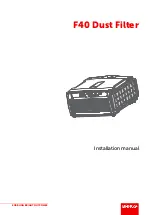
INS
TALLA
TION
W
ARRANT
Y
MAINTENANCE
OPERA
TION
O
VER
VIEW
TROUBLESHOOTING
Symptom
Possible Cause
Possible Solution
No power
GFCI and/or breaker tripped
Power supply fuse has blown
Transient voltage surge suppressor
(TVSS) damaged
Power supply damaged
Reset GFCI and/or breaker
Replace power supply fuse - see Fuse
Replacement section
Replace TVSS
Replace power supply and use a
TVSS
GFCI or breaker
repeatedly trips
Connection between lamp and lamp
plug is wet
Short-circuit in the electrical
assembly
Clean and dry the lamp plug and
lamp end lamp, check unit for leaks
or condensation
Replace power supply
Leak at inlet or
outlet
Threaded pipe fittings are leaking
Clean threads, reseal with Teflon tape
and retighten
Leak detected
from area of
chamber
Condensation of moist air on cold
chamber (slow accumulation)
O-ring damaged, deteriorated or
incorrectly installed
Sleeve bolt not tight enough
Control humidity or relocate unit
Inspect and replace if deteriorated
Ensure nut is turned completely (to
stops)
Alarm
See Control Panel section
See Control Panel section
System is
operating but
water tests
reveal bacterial
contamination
Equipment downstream of UV
system is acting as a breeding
ground for pathogens
Pathogens are residing in the
distribution lines post-UV
Recontamination from pipe
dead-ends
Ensure UV is the last piece of
treatment equipment
Ensure all distribution lines have
been disinfected with chlorine - see
Disinfecting the Water Lines section
Remove any pipe dead-ends and
flush with chlorine - see Disinfecting
the Water Lines section
The table below is a list of
possible
causes and solutions.
Before replacing parts, please contact
Technical Assistance for any new troubleshooting techniques (1 800 265 7246).
15











































